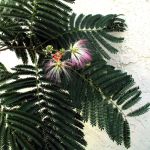| Common Name: |
Silk Tree |
| Botanical Name: |
Albizia julibrissin |
| Genus: |
Albizia |
| Family: |
Mimosaceae |
| Location: |
Iran to Japan |
| Cultivation: |
Well-drained, moisture-retentive soil in full sun. Tolerates poor, alkaline and saline soils, drought, and windy positions. Size and shape may be controlled by cutting back the previous year's growth to 5-6 buds in spring. Plants may be attacked by webworm, scale insects, and nematodes. The trunk may be killed by vascular wilt disease, leaving the roots to sucker. Young specimens make attractive foliage plants and may be treated as annuals for the purpose. Mature specimens are hardier and more floriferous in relatively poor soils, and also in areas with long, hot summers. |
| Propagation: |
By seed sown when ripe, pre-soaked for 12 hours; by semi-ripe cuttings in summer; by root cuttings in spring; by layering in winter. |
| Harvest: |
Bark is removed in spring or late summer, and flowers as they open; both are dried for decoctions. |
| Height: |
6-10m (20-30ft) |
| :Width |
10m (30ft) |
| Variations: |
alba
white flowers
f. rosea
Pink flowers
This species tends to be fast-growing but short-lived and can become weedy through suckering and copious production of seedlings. |
| Hardiness: |
Z6-9. The form rosea is a bit hardier than the species. |
| Parts Used: |
Bark, flowers (he huan), leaves |
| Properties: |
A bitter, astringent, sedative herb that is also diuretic and analgesic, with stimulant effects on the circulation, uterus, and appetite (bark); the flowers are tranquilizing and relieve indigestion. |
| Medicinal Uses: |
Internally for insomnia and irritability (bark, flowers), boils and carbuncles (bark), breathlessnessm and poor memory (flowers). Externally for injuries, swellings, and lung abscesses (bark). |
| Culinary Uses: |
Flowers and young leaves are edible. Dried leaves are used for tea. |
| Bibliography: |
Encylopedia of Herbs by Deni Brown Copyright ©: 1995, 2001 Dorling Kindersley Limited pg 109
|

